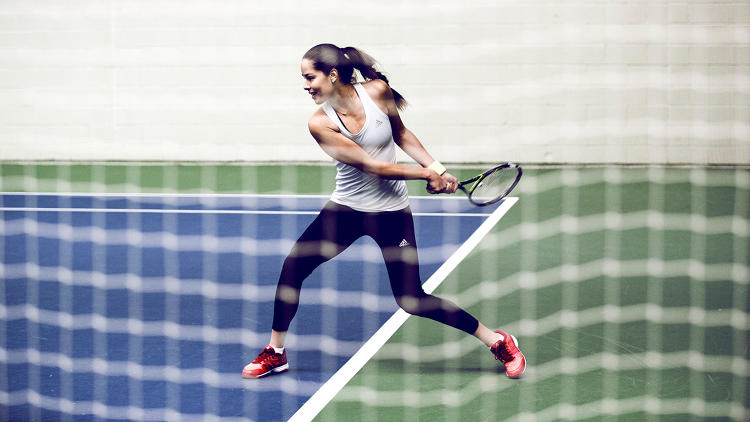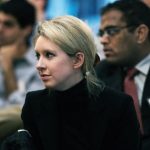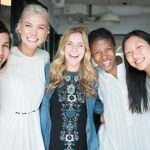Adidas Makes A Play For Women
This year, in a stark change of strategy, Adidas released a series of videos that offer a glimpse into the lives of sporty female celebrities. Supermodel Karlie Kloss is shown coding, doing pirouettes, and baking cookies. “Creating is delicious,” Kloss says, before winking at the camera. DJ Hannah Bronfman goes from surfing to frying up octopus to showing off nail art. Women’s NBA All-Star Candace Parker does headstands before hanging out with her daughter in matching pajamas. “My mom is a beast,” her daughter Lailaa squeaks at the camera.
Throughout its 96-year history, the German athletic-wear company has partnered with athletes at the top of their game. As far back as the 1936 Olympics, Adidas sponsored the African-American sprinter Jesse Owens. From the very start of David Beckham’s football career in the early ’90s, he’s worn Adidas football boots. In 2012, Adidas signed basketball star Derrick Rose and created a shoe that bears his name.
The company’s biggest sport stars were almost always male. But these days, it’s making a concerted effort to reach female consumers, and the company’s branding strategists have determined that women respond to a different message. Rather than portraying women focused on a single sport, they believe female consumers will respond to images of women who incorporate their athletic pursuits into a busy lifestyle.
The Advent Of Athleisure
This shift comes, in part, because of broader cultural changes. According to Morgan Stanley Research, sports participation among high school girls has jumped from 17% to 35% in the last 35 years, which has cultivated a generation of women who want to incorporate fitness into their everyday life. This has driven the so-called “athleisure” trend: Activewear has moved out of the gym, with women wearing stylish yoga leggings and sweatpants to brunch and even the office.
Brands have been quick to adapt to these changing norms. “There’s been a notable change in women’s retail, with every single brand—from H&M to Zara—having sportswear within their mix,” says Alison Stewart, VP of global brand strategy at Adidas. “There are more and more players coming in.” Sportswear sales have increased 42% over the last seven years and currently make up a $270 billion global market. According to Morgan Stanley’s projections, the outlook for sportswear over the next five years looks even more promising.
And yet, during the very same period that people were filling their closets with more sneakers and running pants than ever, Adidas sales have been in decline. The company saw a 38% drop in its share price from 2014 to 2015, with sales plummeting by the same percentage. Adidas has also been losing market share: For decades, it was the second largest sportswear company in the world after Nike, but in 2014, Under Armour overtook it, pushing it into third place. As of last year, Nike owned 45.2% of the sports footwear market and 27.8% of the sports apparel market, while Adidas owned 5.5% and 4.5% of those categories respectively.
So now, Adidas is playing catchup. One part of the company’s current five-year plan, according to Stewart, is to build a brand that will appeal to the woman currently buying athleisure clothing—a customer that Adidas describes as the versatile female athlete.

Lessons From Lululemon
To tackle this challenge, Adidas has created key management positions that focus on catering to women. In February, Nicole Vollebregt, who has worked for Adidas in various roles for nearly two decades, became the company’s first head of global women’s business. “My team is tasked with championing the versatile female athlete throughout the organization,” Vollebregt says. “We work with all the other business units to make sure that we’re delivering products and experiences that she wants.”
The company also hired Christine Day, who was Lululemon’s CEO from 2008 to 2013, to be a strategic adviser. Day has valuable insight about why women’s activewear has become so popular in recent years, since Lululemon has often been described as the brand that ushered in the “athleisure” era by creating chic yoga pants that women wear all day. But Day is quick to point out that “athleisure” does not accurately describe what some women are looking for in their outfits, because the term suggests that they aren’t serious athletes. “The women I know who go to power yoga or spin class are not casual,” Day says. “Athleisure has led to a lot of poor-quality garments that aren’t really suited for performance sports. It’s become just a new form of casual wear.”
She makes the case that a lot of brands on the market—including Lululemon—do a disservice to women by creating fashionable pieces that don’t perform. After years of scrutinizing activewear, she’s concluded that many clothes that are marketed for sports don’t live up to the challenge. They chafe, don’t have flat-seaming or four-way stretch, and don’t offer coverage or support for intense activity. She believes that Adidas can try to regain its footing by creating better quality products that its competitors, while also ensuring that the garments and shoes are as stylish as those created by fashion brands. “Sewing with two different fabrics is a very complex thing to do,” Day says. “Adidas has years and years of technical research that make it possible for them to achieve this.”
This year, Adidas rolled out a shoe called the Pure Boost X. Rather than simply adapting male running shoes for women, which it had previously done, the company invested in studying the female foot in motion to create a shoe that would adapt to it. Since women have higher arches, the Pure Boost X has a floating arch that the company claims will deliver more support. “It’s the first running shoe that was designed specifically for a woman’s foot,” Vollebregt says. (It is worth noting that Ryka has been designing shoes for women’s feet for 25 years.)
Adidas has already developed a bra with a heart-rate monitor built into it and has a pipeline of other garments that incorporate wearable technology. Vollebregt says that Adidas will continue to release products like this over the next few years that will help the brand stand out in a crowded marketplace. “We’re reaching out to women who really see themselves as athletes in their post-collegiate life,” Vollebregt says. “But that performance technology that we have, whether that’s fabric or running shoes, is huge, and that’s something that all of those fashion brands don’t have.”

Speaking To The Versatile Female Athlete
It’s one thing to create high-performing products for this versatile female athlete, but it’s an entirely different challenge to get her attention and create a brand that speaks her language. Day makes the case that unlike men, women are not particularly inspired by the prowess of top soccer players or Olympians, but are motivated by being part of a community. “Hero athletes aren’t as big a deal to women,” Day says. “They are more influenced by other women and purpose and health and wellness.”
This observation is borne out in the data that Adidas has collected from MiCoach, its fitness training app. When it comes to workout patterns, there are clear gender differences. Men’s running times tend to cluster around even time increments—five or 10 minutes, for instance—suggesting that they are trying to improve on their personal best. Women, on the other hand, tend to run in groups, so their running times cluster with those of the friends they run with.
“Young males are really interested in honing and perfecting their craft as an athlete,” says Stacey Burr, the general manager of the digital sport business division at Adidas. “It’s about how they can run faster, jump higher, kick the ball with a better technique. Women are more interested in the participation and completion aspect of it, and the social aspect of sharing their experience in the race.” Adidas has discovered that women are twice as likely to use fitness trackers and apps as their male counterparts, perhaps because they are more interested in the community-oriented nature of these devices.
Adidas has responded to these findings by reaching out to real-life communities of active women. It recently announced a partnership with Wanderlust, which plans massive yoga festivals and events. Eighty-five percent of those who attend Wanderlust get-togethers are women, and the majority of them are millennials. Adidas will be highly visible at all of Wanderlust’s 108 U.S.-based events, selling products and doing brand activations. The company is also starting a large influencer program with Wanderlust participants by creating a consortium of top athletes who will lead running and yoga courses.
This collaboration also takes a page from the Lululemon playbook. “Yoga was very important to the Lululemon mind-set because it said something about being mindful, so women were really joining the yoga movement,” Day says. “It was a brand halo for Lululemon.”

Adidas’s ultimate goal is to rebrand itself as a company that women will identify with. Day believes that this has been hard to achieve in the past because Adidas is a manufacturer, so its products appear in a wide variety of places—from Bloomingdales to Dick’s Sporting Goods to discount outlets—which makes it hard to control its own image. Adidas is hoping to right the course by claiming a voice on its own channels, from its website to its brick-and-mortar stores to its social media streams. The video series of women incorporating sports into their lives is a good example of this strategy at work. “When we embark on something new, it may take us a little longer because we are a big organization,” Vollebregt says. “But once we decide on an initiative and turn on the tap, we can ramp up extremely quickly, because we have thousands of our own stores globally.”















Fast Company , Read Full Story
(56)














